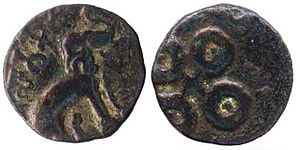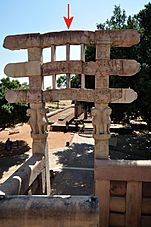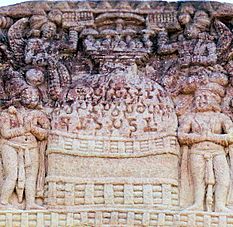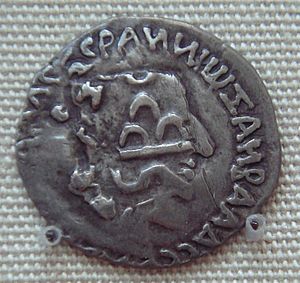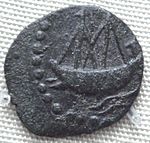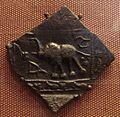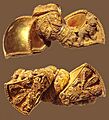Satavahana dynasty facts for kids
Quick facts for kids
Satavahana Empire
|
|||||||||||||||||||||
|---|---|---|---|---|---|---|---|---|---|---|---|---|---|---|---|---|---|---|---|---|---|
| Late 2nd century BCE–Early 3rd century CE | |||||||||||||||||||||
| Capital | Pratishthana Amaravati |
||||||||||||||||||||
| Common languages | Prakrit Sanskrit |
||||||||||||||||||||
| Religion | Hinduism Buddhism |
||||||||||||||||||||
| Government | Monarchy | ||||||||||||||||||||
| King | |||||||||||||||||||||
| Historical era | Classical India | ||||||||||||||||||||
|
• Established
|
Late 2nd century BCE | ||||||||||||||||||||
|
• Disestablished
|
Early 3rd century CE | ||||||||||||||||||||
|
|||||||||||||||||||||
| Today part of | India | ||||||||||||||||||||
The Satavahanas were an ancient Indian kingdom. They were also called the Andhras in old stories. This powerful dynasty ruled the Deccan Plateau region of India. Most experts think they ruled from the late 2nd century BCE to the early 3rd century CE.
Their kingdom mainly covered parts of modern Andhra Pradesh, Telangana, and Maharashtra. Sometimes, their rule reached into Gujarat, Madhya Pradesh, and Karnataka. They had different capital cities, like Pratishthana (Paithan) and Amaravati.
The Satavahanas brought peace to the Deccan after the Mauryan Empire ended. They fought against foreign invaders, especially the Saka Western Satraps. The kingdom was strongest under kings Gautamiputra Satakarni and his son Vasisthiputra Pulamavi. By the early 3rd century CE, their kingdom split into smaller states.
The Satavahanas were among the first Indian rulers to make their own coins with pictures of their kings. They helped connect northern and southern India through trade and shared ideas. They supported both Hinduism and Buddhism. They also encouraged literature in the Maharashtri Prakrit language.
Contents
Who Were the Satavahanas?
Historians debate when and where the Satavahana dynasty started. They also discuss what their name means. Different parts of India today, like Maharashtra, Andhra Pradesh, Karnataka, and Telangana, claim to be their original home.
What Does the Name "Satavahana" Mean?
One idea is that "Satavahana" comes from the Sanskrit words Sapta-Vahana. This means "driven by seven." In Hindu stories, the sun god's chariot is pulled by seven horses. This might mean the Satavahanas linked themselves to the sun god's family.
Another idea is that the name comes from sata ("swift") and vahana ("vehicle"). So, it could mean "one who rides a swift horse." Some scholars also think "Satakarni" means "one with lion ears" or "one who uses a lion as a vehicle."
The old Indian texts called Puranas refer to the Satavahanas as "Andhras." This name might refer to their people or the land they came from. However, the Satavahanas themselves did not use this name in their own records.
Where Did the Satavahanas Come From?
Some historians believe the Satavahanas started in the eastern Deccan region. This area is now Andhra Pradesh and Telangana. Coins found in Kotilingala (Telangana) have names like "Rano Siri Chimuka Satavahanasa." Some thought this "Chimuka" was Simuka, the dynasty's founder.
However, other historians think the Satavahanas began in the western Deccan, which is modern Maharashtra. The oldest Satavahana writings (inscriptions) from around the 1st century BCE are found there. For example, an inscription in the Pandavleni Caves near Nashik mentions King Kanha.
Coins of early kings like Satakarni I have also been found in Maharashtra. This suggests they first gained power around their capital, Pratishthana (Paithan) in Maharashtra. Then, they expanded their kingdom eastward.
The Puranas called the Satavahana kings Andhrabhrityas, meaning "servants of the Andhras." This might mean they were originally servants of the Mauryas or other Andhra rulers. Some scholars even suggest they came from Karnataka. A sculpture at Kanaganahalli in Karnataka shows early Satavahana rulers like Simuka and Satakarni.
How the Satavahana Kingdom Grew
We learn about the Satavahanas from old texts, inscriptions, coins, and foreign writings. This information helps us understand their history, but some parts are still debated.
The Kingdom's Beginning
Simuka is named as the first king in a Satavahana inscription. The Puranas say the first king ruled for 23 years. His name is spelled differently in various texts, but it's likely Simuka.
Some Puranas say the Satavahana rule lasted about 450 years. If their rule ended in the early 3rd century CE, it means they started in the 3rd century BCE. An ancient Greek writer, Megasthenes, mentioned a powerful tribe called "Andarae" around 300 BCE. If these were the Andhras, it supports an earlier start date.
However, most modern scholars believe the Satavahana rule began in the 1st century BCE. This idea is based on both old texts and archaeological finds like coins. The oldest known Satavahana inscription, from Kanaganahalli, mentions "King Siri Chimuka Sātavāhana" in his 16th year, around 110 BCE.
Early Expansion of Power
Simuka's brother, Kanha, became king after him. Kanha expanded the kingdom west to Nashik. His successor, Satakarni I, took over western Malwa and other areas. He did this by taking advantage of the chaos caused by Greek invasions in northern India. Satakarni I performed important Vedic religious ceremonies and gave money to Brahmins.
Satakarni II ruled for 56 years. He captured eastern Malwa from the Shunga Empire. This gave him access to the Buddhist site of Sanchi. He is known for building the beautiful decorated gateways around the stupas at Sanchi. An inscription there mentions a gift from the artisans of "rajan Siri Satakarni."
Fighting the Western Satraps
After some short-reigning kings, the Satavahana kingdom faced tough times. The Western Kshatrapas, their neighbors to the north, took over some of their land. The Western Kshatrapa ruler Nahapana controlled former Satavahana areas.
The First Comeback
The Satavahana kingdom became strong again under Gautamiputra Satakarni. He is thought to be the greatest Satavahana ruler. He defeated the Western Kshatrapa ruler Nahapana. This is shown by Nahapana's coins, which Gautamiputra restruck with his own name.
An inscription from his mother, Gautami Balashri, describes his great achievements. It says his kingdom stretched from modern Rajasthan in the north to the Krishna river in the south. It also went from Saurashtra in the west to Kalinga in the east. He was called "King of Kings" and "Great King."
His mother's inscription also says he "crushed down the pride and conceit of the Kshatriyas" and "destroyed the Sakas, Yavanas, and Pahlavas." This means he defeated many rival groups.
Gautamiputra's son, Vasisthiputra Sri Pulamavi (Pulumayi), took over after him. Pulumavi's many inscriptions and widespread coins show that he kept his father's large kingdom strong and prosperous. His coins even show ships, suggesting he was involved in sea trade.
Another Invasion by Western Satraps
Pulumavi's brother, Vashishtiputra Satakarni, became king next. He made a peace agreement with the Western Satraps by marrying the daughter of their ruler, Rudradaman I.
However, Rudradaman I later defeated Satakarni twice. An inscription says Rudradaman spared Satakarni's life because of their family connection. After these defeats, the Satavahana kingdom became smaller, mostly limited to the Deccan and areas around Amaravati.
The Second Comeback and Decline
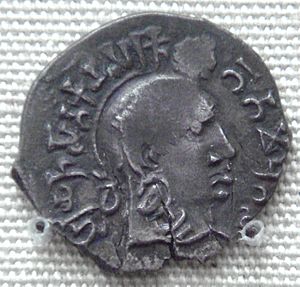
Sri Yajna Sātakarni was the last important king of the main Satavahana family. He brought the kingdom back to power for a short time. His coins show ships, which means he was successful in sea trade. His rule covered both eastern and western parts of the Deccan. He also won back some land from the Western Kshatrapas.
After Yajna Satakarni, the Satavahana dynasty weakened and eventually ended. Smaller kingdoms that used to be part of their empire became independent. The empire split into five smaller kingdoms:
- A northern part ruled by a different branch of the Satavahanas.
- A western part around Nashik, ruled by the Abhira dynasty.
- An eastern part (Krishna-Guntur region), ruled by the Andhra Ikshvakus.
- South-western parts (northern Karnataka), ruled by the Chutu dynasty.
- South-eastern part, ruled by the Pallava dynasty.
How the Satavahanas Ruled
The Satavahanas followed old Indian rules for governing. Their government was not as strict as the Mauryan Empire. They had different levels of rulers:
- Rajan: The main kings who inherited their power.
- Rajas: Smaller princes who made their own coins.
- Maharathis: Important lords who could give away villages and had family ties with the royal family.
- Mahabhojas and Mahasenapati (military commanders or governors).
Royal princes were often made governors of different regions. The kingdom was divided into areas called praharas, which were named after their governors. This shows they tried to create a clear system for ruling and collecting taxes.
Inscriptions show that the Satavahanas had a system of officials. For example, some inscriptions record land given to religious groups. These lands were free from taxes and royal officials could not interfere. This shows a structured way of managing the kingdom.
The Satavahana kingdom had different types of settlements: nagara (cities), nigama (market towns), and gāma (villages). The Satavahanas were known as "lords of the three oceans." They encouraged trade with other countries and helped spread Buddhist art and architecture.
Satavahana Economy and Trade
The Satavahanas helped their economy grow. They improved farming, made more goods, and traded a lot within India and with other countries.
During their time, many large towns grew in fertile areas, especially along rivers. More land was used for farming as forests were cleared and irrigation systems were built.
Mining also increased, leading to new settlements near mineral resources. This helped with trade and crafts like making pottery. More craft production is seen in archaeological finds and mentions of artisans and guilds (groups of skilled workers).
The Satavahanas controlled the Indian coastline. This helped them control the growing trade with the Roman Empire. Important trade centers included Pratishthana and Tagara. Nanaghat was a key mountain pass connecting their capital to the sea.
Religion and Culture
The Satavahanas were mainly Hindus and claimed to be of the Brahmana class. However, they also gave many gifts to Buddhist monasteries. People during the Satavahana period often supported different religious groups without choosing just one.
The Naneghat inscription mentions that King Satakarni I performed several Vedic sacrifices. These included the ashvamedha (horse sacrifice). The inscription also records large payments given to Brahmin priests for these ceremonies.
Many Buddhist monasteries appeared in the Deccan during the Satavahana period. While some royals donated to them, most donations came from ordinary people, especially merchants. These monasteries were often located along important trade routes. They might have served as rest stops for traders and even helped with trade.
Language and Writing
The Satavahanas mostly used a language called Prakrit in their inscriptions and on their coins. This language was similar to Sanskrit but simpler.
King Hāla is famous for putting together a collection of poems called the Gaha Sattasai in Maharashtri Prakrit. This book shows that farming was the main way people lived.
The Satavahanas also used Sanskrit in some political inscriptions. Some of their coins were bilingual, meaning they had writing in two languages. One side was in Prakrit, and the other side was in a Dravidian language (possibly Old Tamil).
Art and Architecture
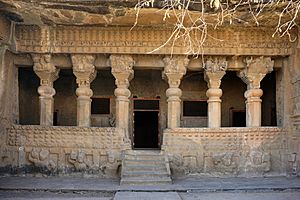
The Satavahanas were important for their contributions to Buddhist art and buildings. They built large Buddhist stupas (dome-shaped structures for meditation) in the Krishna River Valley. The most famous are the stupas at Amaravati and Nagarjunakonda.
These stupas were decorated with marble slabs carved with scenes from the life of the Buddha. The carvings show a unique slim and elegant style, known as the Amaravati style. This style also influenced art in Southeast Asia.
The Satavahana period also saw the creation of some of the earliest surviving paintings in India. These are found in the Ajanta Caves. Only a few parts of these paintings remain, like the Chhadanta Jataka in Cave No. 10. This painting tells a mythological story about an elephant.
The human figures in these paintings look very similar to those seen on the Sanchi Gateways, showing their clothing and jewelry.
Who Were the Satavahana Rulers?
Old texts called Puranas list the Satavahana kings. However, these lists often disagree on the number of kings, their names, and how long they ruled. Also, some kings found on coins and inscriptions are not in the Puranas.
Historians have two main ideas about the Satavahana timeline:
- Some believe 30 Satavahana kings ruled for about 450 years, starting right after the Mauryan Empire fell. This idea is not widely accepted now.
- Most modern scholars believe the Satavahana rule started around the 1st century BCE. These timelines have fewer kings and combine information from Puranas, archaeology, and coins.
Because the exact start date is uncertain, it's hard to give exact dates for each king's rule.
List of Rulers Based on Archaeology
Here is a list of Satavahana rulers based on archaeological finds and coins:
| Number | Ruler | Approximate Reign |
|---|---|---|
| 1 | Simuka | Before 100 BCE |
| 2 | Kanha | c. 100–70 BCE |
| 3 | Satakarni I | c. 70–60 BCE |
| 4 | Satakarni II | c. 50–25 BCE |
| Time when Western Kshatrapas ruled, with Satavahana kings as vassals | ||
| 5 | Hāla (ruled under Kshatrapas) | c. 20–24 CE |
| 6 | Nahapana (Kshatrapas King) | c. 54–100 CE |
| Satavahana Dynasty Restored | ||
| 7 | Gautamiputra Satakarni | c. 86–110 CE |
| 8 | Pulumavi | c. 110–138 CE |
| 9 | Vashishtiputra Satakarni | c. 138–145 CE |
| 10 | Shiva Shri Pulumavi | c. 145–152 CE |
| 11 | Shiva Skanda Satakarni | c. 145–152 CE |
| 12 | Yajna Shri Satakarni | c. 152–181 CE |
| 13 | Vijaya Satakarni | Until c. 200 CE |
| Later Satavahana Rulers in South-Eastern Deccan | ||
| 14 | Chandra Shri | 3rd century CE |
| 15 | Pulumavi II | 3rd century CE |
| 16 | Abhira Isvarasena | 3rd century CE |
| 17 | Madhariputra Sakasena | 3rd century CE |
| 18 | Haritiputra Satakarni | 3rd century CE |
Images for kids
-
Royal earrings from Andhra Pradesh, 1st century BCE.
See also
 In Spanish: Dinastía Satavájana para niños
In Spanish: Dinastía Satavájana para niños


